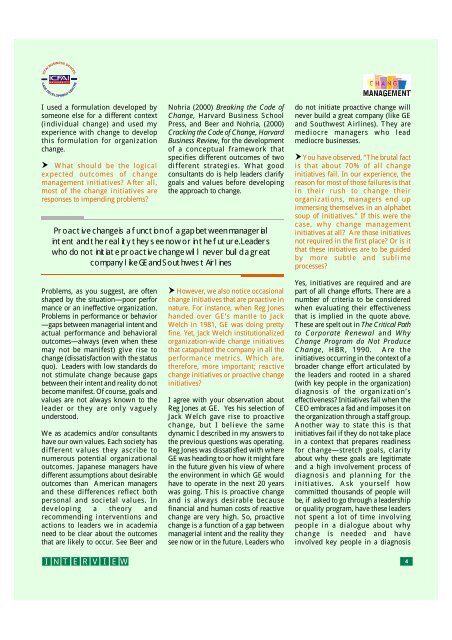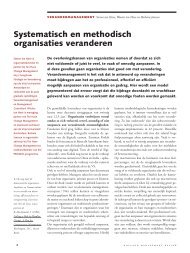Interview with Michael Beer - Change Management Online
Interview with Michael Beer - Change Management Online
Interview with Michael Beer - Change Management Online
Create successful ePaper yourself
Turn your PDF publications into a flip-book with our unique Google optimized e-Paper software.
I used a formulation developed by<br />
someone else for a different context<br />
(individual change) and used my<br />
experience <strong>with</strong> change to develop<br />
this formulation for organization<br />
change.<br />
� What should be the logical<br />
expected outcomes of change<br />
management initiatives? After all,<br />
most of the change initiatives are<br />
responses to impending problems?<br />
Problems, as you suggest, are often<br />
shaped by the situation—poor perfor<br />
mance or an ineffective organization.<br />
Problems in performance or behavior<br />
—gaps between managerial intent and<br />
actual performance and behavioral<br />
outcomes—always (even when these<br />
may not be manifest) give rise to<br />
change (dissatisfaction <strong>with</strong> the status<br />
quo). Leaders <strong>with</strong> low standards do<br />
not stimulate change because gaps<br />
between their intent and reality do not<br />
become manifest. Of course, goals and<br />
values are not always known to the<br />
leader or they are only vaguely<br />
understood.<br />
We as academics and/or consultants<br />
have our own values. Each society has<br />
different values they ascribe to<br />
numerous potential organizational<br />
outcomes. Japanese managers have<br />
different assumptions about desirable<br />
outcomes than American managers<br />
and these differences reflect both<br />
personal and societal values. In<br />
developing a theory and<br />
recommending interventions and<br />
actions to leaders we in academia<br />
need to be clear about the outcomes<br />
that are likely to occur. See <strong>Beer</strong> and<br />
I N T E R V I EW<br />
Nohria (2000) Breaking the Code of<br />
<strong>Change</strong>, Harvard Business School<br />
Press, and <strong>Beer</strong> and Nohria, (2000)<br />
Cracking the Code of <strong>Change</strong>, Harvard<br />
Business Review, for the development<br />
of a conceptual framework that<br />
specifies different outcomes of two<br />
different strategies. What good<br />
consultants do is help leaders clarify<br />
goals and values before developing<br />
the approach to change.<br />
Proactive change is a function of a gap between managerial<br />
intent and the reality they see now or in the future. Leaders<br />
who do not initiate proactive change will never build a great<br />
company like GE and Southwest Airlines<br />
� However, we also notice occasional<br />
change initiatives that are proactive in<br />
nature. For instance, when Reg Jones<br />
handed over GE’s mantle to Jack<br />
Welch in 1981, GE was doing pretty<br />
fine. Yet, Jack Welch institutionalized<br />
organization-wide change initiatives<br />
that catapulted the company in all the<br />
performance metrics. Which are,<br />
therefore, more important; reactive<br />
change initiatives or proactive change<br />
initiatives?<br />
I agree <strong>with</strong> your observation about<br />
Reg Jones at GE. Yes his selection of<br />
Jack Welch gave rise to proactive<br />
change, but I believe the same<br />
dynamic I described in my answers to<br />
the previous questions was operating.<br />
Reg Jones was dissatisfied <strong>with</strong> where<br />
GE was heading to or how it might fare<br />
in the future given his view of where<br />
the environment in which GE would<br />
have to operate in the next 20 years<br />
was going. This is proactive change<br />
and is always desirable because<br />
financial and human costs of reactive<br />
change are very high. So, proactive<br />
change is a function of a gap between<br />
managerial intent and the reality they<br />
see now or in the future. Leaders who<br />
do not initiate proactive change will<br />
never build a great company (like GE<br />
and Southwest Airlines). They are<br />
mediocre managers who lead<br />
mediocre businesses.<br />
� You have observed, “The brutal fact<br />
is that about 70% of all change<br />
initiatives fail. In our experience, the<br />
reason for most of those failures is that<br />
in their rush to change their<br />
organizations, managers end up<br />
immersing themselves in an alphabet<br />
soup of initiatives.” If this were the<br />
case, why change management<br />
initiatives at all? Are those initiatives<br />
not required in the first place? Or is it<br />
that these initiatives are to be guided<br />
by more subtle and sublime<br />
processes?<br />
Yes, initiatives are required and are<br />
part of all change efforts. There are a<br />
number of criteria to be considered<br />
when evaluating their effectiveness<br />
that is implied in the quote above.<br />
These are spelt out in The Critical Path<br />
to Corporate Renewal and Why<br />
<strong>Change</strong> Program do Not Produce<br />
<strong>Change</strong>, HBR, 1990. Are the<br />
initiatives occurring in the context of a<br />
broader change effort articulated by<br />
the leaders and rooted in a shared<br />
(<strong>with</strong> key people in the organization)<br />
diagnosis of the organization’s<br />
effectiveness? Initiatives fail when the<br />
CEO embraces a fad and imposes it on<br />
the organization through a staff group.<br />
Another way to state this is that<br />
initiatives fail if they do not take place<br />
in a context that prepares readiness<br />
for change—stretch goals, clarity<br />
about why these goals are legitimate<br />
and a high involvement process of<br />
diagnosis and planning for the<br />
initiatives. Ask yourself how<br />
committed thousands of people will<br />
be, if asked to go through a leadership<br />
or quality program, have these leaders<br />
not spent a lot of time involving<br />
people in a dialogue about why<br />
change is needed and have<br />
involved key people in a diagnosis<br />
4








